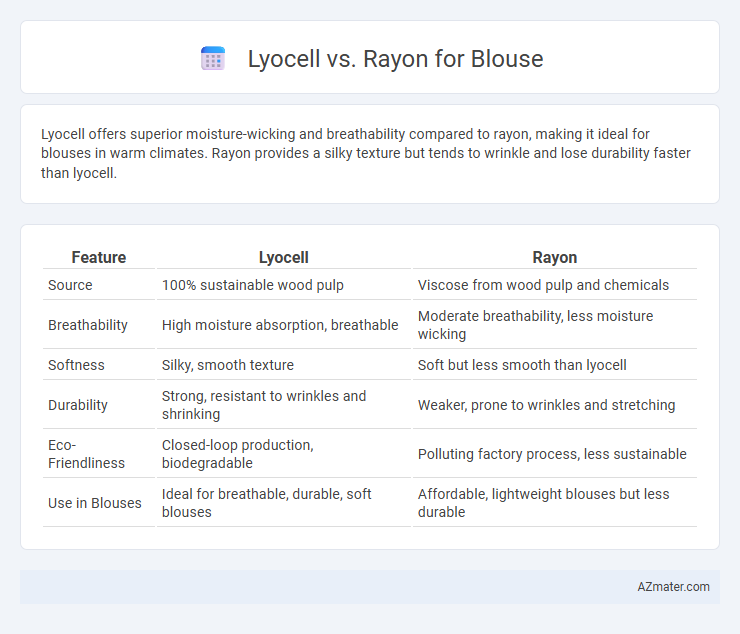Lyocell offers superior moisture-wicking and breathability compared to rayon, making it ideal for blouses in warm climates. Rayon provides a silky texture but tends to wrinkle and lose durability faster than lyocell.
Table of Comparison
| Feature | Lyocell | Rayon |
|---|---|---|
| Source | 100% sustainable wood pulp | Viscose from wood pulp and chemicals |
| Breathability | High moisture absorption, breathable | Moderate breathability, less moisture wicking |
| Softness | Silky, smooth texture | Soft but less smooth than lyocell |
| Durability | Strong, resistant to wrinkles and shrinking | Weaker, prone to wrinkles and stretching |
| Eco-Friendliness | Closed-loop production, biodegradable | Polluting factory process, less sustainable |
| Use in Blouses | Ideal for breathable, durable, soft blouses | Affordable, lightweight blouses but less durable |
Introduction to Lyocell and Rayon
Lyocell and rayon are both semi-synthetic fibers commonly used in blouse fabrics, but they differ significantly in production and environmental impact. Lyocell is made from sustainably sourced wood pulp using a closed-loop process that recycles solvents, making it a more eco-friendly option with superior breathability and moisture-wicking properties. Rayon, derived from cellulose fibers treated with chemicals like carbon disulfide, offers a soft texture and vibrant drape but involves a more chemically intensive manufacturing process, impacting its sustainability profile.
Understanding the Lyocell Fabric
Lyocell fabric, derived from sustainably sourced wood pulp, offers superior breathability and moisture-wicking properties compared to traditional rayon, making it ideal for blouses in warm climates. Its closed-loop production process reduces environmental impact, enhancing its appeal for eco-conscious consumers seeking soft, durable, and wrinkle-resistant fabric. Unlike rayon, Lyocell resists shrinking and maintains fabric integrity after repeated washes, providing long-lasting comfort and style in blouse design.
What is Rayon?
Rayon is a semi-synthetic fiber made from cellulose derived from wood pulp, commonly used in blouse fabrics for its smooth texture and breathability. Compared to lyocell, rayon undergoes a more chemically intensive production process, which can affect its environmental impact and durability. Rayon fabric offers a soft, lightweight feel with excellent drape, making it a popular choice for stylish and comfortable blouses.
Key Differences Between Lyocell and Rayon
Lyocell and rayon differ primarily in their production processes and environmental impact, with lyocell made using a closed-loop system that recycles solvents, making it more eco-friendly compared to the chemically intensive process of rayon. Lyocell fibers offer greater durability, moisture-wicking properties, and a smoother texture, which enhances comfort and breathability in blouses, whereas rayon tends to be softer but less robust and more prone to wrinkling. Choosing lyocell blouses supports sustainability and performance, while rayon remains a cost-effective option with a silk-like appearance.
Breathability and Comfort Comparison
Lyocell fabric offers superior breathability and moisture-wicking properties compared to rayon, making it a more comfortable choice for blouses in warm climates. Rayon, while soft and smooth, tends to retain heat and moisture, which can reduce comfort during extended wear. The sustainable production process of Lyocell enhances its appeal, providing a breathable, eco-friendly option without sacrificing softness or drape.
Durability and Longevity of Blouses
Lyocell fabric offers superior durability and longevity for blouses compared to rayon, due to its stronger fibers and resistance to wear and tear during washing and daily use. Rayon, while soft and breathable, tends to lose strength and shape faster, resulting in a shorter lifespan for blouses made from this material. Choosing lyocell ensures blouses maintain their integrity and appearance over time, making it a more sustainable and cost-effective option.
Environmental Impact: Lyocell vs Rayon
Lyocell, derived from sustainably sourced wood pulp, employs a closed-loop production process that recycles water and solvents, significantly reducing environmental pollution compared to conventional rayon. Rayon manufacturing involves heavy chemical use, including toxic carbon disulfide, contributing to deforestation, water contamination, and higher carbon emissions. Choosing lyocell for blouses supports eco-friendly fashion by minimizing waste and promoting biodegradability, whereas rayon's environmental footprint remains substantially larger due to less sustainable production practices.
Care and Maintenance Requirements
Lyocell blouses require gentle machine washing in cold water and low heat tumble drying to preserve fabric strength and reduce shrinkage, while rayon blouses often need hand washing or dry cleaning to prevent damage and maintain fabric integrity. Lyocell's moisture-wicking properties promote quick drying and reduced odor, making it easier to care for compared to rayon, which is more prone to wrinkles and color fading during laundering. Using mild detergents and avoiding bleach ensure the longevity and softness of both Lyocell and rayon blouses, but Lyocell offers a more durable and eco-friendly option with less intensive maintenance.
Price and Accessibility for Blouses
Lyocell blouses typically cost more than rayon blouses due to the sustainable production process and higher-quality fibers, making Lyocell a premium option in the market. Rayon blouses are more affordable and widely accessible, commonly found in fast fashion and budget-friendly brands, which makes rayon a popular choice for everyday wear. Availability of rayon blouses is higher across various retail outlets compared to Lyocell, which is often sold by specialty or eco-conscious brands.
Which is Better for Blouses: Lyocell or Rayon?
Lyocell outperforms rayon for blouses due to its superior moisture-wicking properties and enhanced breathability, making it ideal for all-day comfort. Unlike rayon, lyocell is produced through an eco-friendly closed-loop process that reduces environmental impact, appealing to sustainable fashion consumers. The fabric's strength and wrinkle resistance ensure that lyocell blouses maintain a polished look longer than rayon counterparts.

Infographic: Lyocell vs Rayon for Blouse
 azmater.com
azmater.com